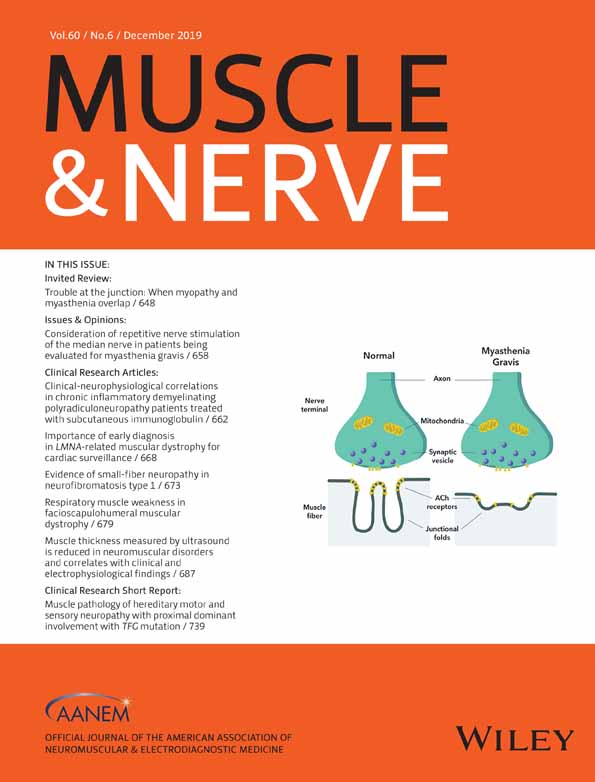Utility of neuromuscular ultrasound for electromyographic needle localization within diseased muscle
Omar F. Ahmad MD
EMG Section, National Institute of Neurological Disorders and Stroke, National Institutes of Health, Bethesda, Maryland
Mount Carmel St Ann's Hospital, Columbus, Ohio
Search for more papers by this authorDimah Saade MD
Neuromuscular and Neurogenetic Disorders of Childhood Section, National Institute of Neurological Disorders and Stroke, National Institutes of Health, Bethesda, Maryland
Search for more papers by this authorA. Reghan Foley MD
Neuromuscular and Neurogenetic Disorders of Childhood Section, National Institute of Neurological Disorders and Stroke, National Institutes of Health, Bethesda, Maryland
Search for more papers by this authorCarsten Bönnemann MD
Neuromuscular and Neurogenetic Disorders of Childhood Section, National Institute of Neurological Disorders and Stroke, National Institutes of Health, Bethesda, Maryland
Search for more papers by this authorCorresponding Author
Tanya Lehky MD
EMG Section, National Institute of Neurological Disorders and Stroke, National Institutes of Health, Bethesda, Maryland
Correspondence
Tanya Lehky, EMG Section, NINDS, NIH, Building 10, Room 7-5680, Bethesda, MD 20892-1404.
Email: [email protected]
Search for more papers by this authorOmar F. Ahmad MD
EMG Section, National Institute of Neurological Disorders and Stroke, National Institutes of Health, Bethesda, Maryland
Mount Carmel St Ann's Hospital, Columbus, Ohio
Search for more papers by this authorDimah Saade MD
Neuromuscular and Neurogenetic Disorders of Childhood Section, National Institute of Neurological Disorders and Stroke, National Institutes of Health, Bethesda, Maryland
Search for more papers by this authorA. Reghan Foley MD
Neuromuscular and Neurogenetic Disorders of Childhood Section, National Institute of Neurological Disorders and Stroke, National Institutes of Health, Bethesda, Maryland
Search for more papers by this authorCarsten Bönnemann MD
Neuromuscular and Neurogenetic Disorders of Childhood Section, National Institute of Neurological Disorders and Stroke, National Institutes of Health, Bethesda, Maryland
Search for more papers by this authorCorresponding Author
Tanya Lehky MD
EMG Section, National Institute of Neurological Disorders and Stroke, National Institutes of Health, Bethesda, Maryland
Correspondence
Tanya Lehky, EMG Section, NINDS, NIH, Building 10, Room 7-5680, Bethesda, MD 20892-1404.
Email: [email protected]
Search for more papers by this authorCONFLICT OF INTEREST
The authors have no conflicts of interest to disclose related to this report.
Supporting Information
| Filename | Description |
|---|---|
| mus26698-sup-0001-VideoS1.mp4MPEG-4 video, 20.2 MB | VIDEO S1 Ultrasound-guided electromyography needling of muscle. The patient is asked to contract his quadriceps. In the beginning of the video, the needle is placed in long axis view, and the shaft of the electromyography needle is visible as it approaches the less echogenic area of muscle, allowing for recording of a single, crisp-sounding motor unit potential. At 00:13, the needle is placed perpendicular to the probe, where the tip of the needle is visible as it moves in and out of the desired target, with corresponding near- and distant-sounding motor unit potentials. At 00:21, the needle is shown to move through the target area of muscle, deep into a hyperechoic area below. The corresponding electromyography signal suddenly sounds distant, and the waveforms take on a positive morphology, as the needle tip moves farther away from the active muscle. At 00:26, the needle is withdrawn back into the target area, and multiple near-sounding, short-duration, low-amplitude, polyphasic motor unit potentials are observed. |
Please note: The publisher is not responsible for the content or functionality of any supporting information supplied by the authors. Any queries (other than missing content) should be directed to the corresponding author for the article.
REFERENCES
- 1Pillen S, Arts IM, Zwarts MJ. Muscle ultrasound in neuromuscular disorders. Muscle Nerve. 2008; 37: 679-693.
- 2Zaidman CM, van Alfen N. Ultrasound in the assessment of myopathic disorders. J Clin Neurophysiol. 2016; 33: 103-111.
- 3Heckmatt JZ, Leeman S, Dubowitz V. Ultrasound imaging in the diagnosis of muscle disease. J Pediatr. 1982; 101: 656-660.
- 4Hodges PW, Pengel LH, Herbert RD, Gandevia SC. Measurement of muscle contraction with ultrasound imaging. Muscle Nerve. 2003; 27: 682-692.
- 5Heckmatt JZ, Dubowitz V. Ultrasound imaging and directed needle biopsy in the diagnosis of selective involvement in muscle disease. J Child Neurol. 1987; 2: 205-213.
- 6Alter KE, Karp BI. Ultrasound guidance for botulinum neurotoxin chemodenervation procedures. Toxins (Basel). 2017; 10(1).
- 7Schramm A, Baumer T, Fietzek U, Heitmann S, Walter U, Jost WH. Relevance of sonography for botulinum toxin treatment of cervical dystonia: an expert statement. J Neural Transm (Vienna). 2015; 122: 1457-1463.




